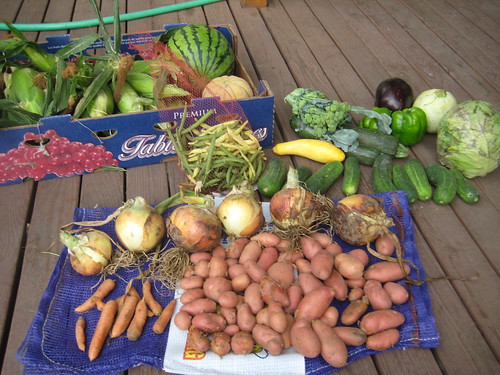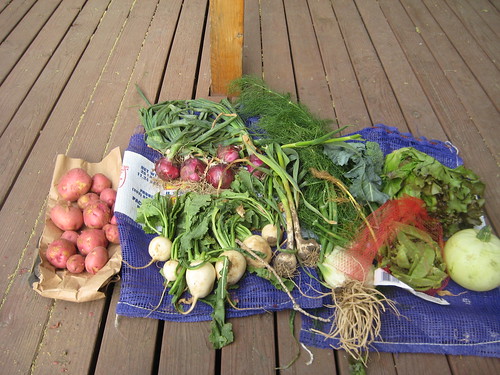
1 watermelon
1 canteloupe
20 ears corn
9 pickling size cukes
3.5# wax and green beans
2 green peppers
1 eggplant
1 cabbage
6 onions
8 sm carrots
2 zuchini
1 yellow squash
1 Q-ball squash
1 broccoli
a heapin mess of taters
Bart Lantz's blog on food, politics and gardening.
Some shareholders said they found the arrangement a bargain compared to grocery shopping, while others considered it a worthwhile indulgence. Most agreed that the urge to buy and spend locally — to avoid the costs and environmental degradation that come with shipping and storage — was behind the decision to join.
..
The downside for people who are used to grocery shopping comes when they want fresh blueberries in January or, as was the case at Erehwon last week, the tomato plants needed more time in the ground because of a cold spring.
“We eat with the seasons, and there’s no guarantee that Mother Nature will cooperate,” Ms. Propst said. “That’s all part of the deal.”

Their role in nature is not to torment you but to cover disturbed ground, to lay claim to any patch laid newly bare and thereby prevent it from blowing or washing away. In the process they provide food and liquid to any creature smart enough to take a bite.
The plant is rich in vitamin E, vitamin C and beta carotene, and quite high in protein. Most noteworthy of all, it is considered a better source of essential omega-3 fatty acids than any other leafy plant. These are compounds the body cannot make itself, which are needed to complement the omega-6 fatty acids we get from grains and grain-fed meat.

I bike, knit and garden in Denver, where I live with my accordionist partner and our banjo playing friend and our cats Seamus and Sherman. We grow some of our food in the garden and are also members of a local CSA.